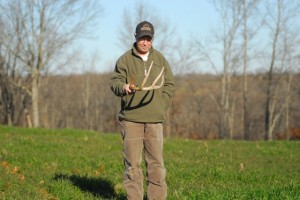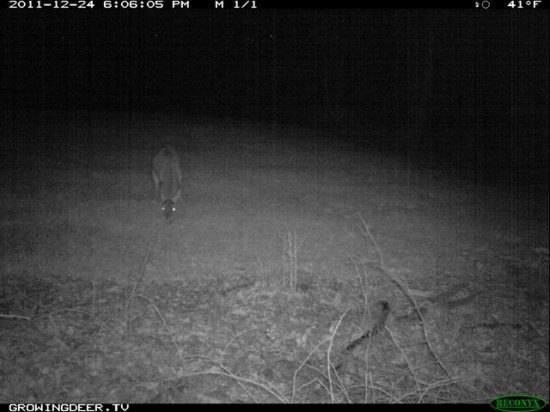Bucks Shedding Antlers Early
Filed under: Deer Management, Hunting Blog, Trail Cameras
Adam called me two days ago with a bitter sweet message. He had found a shed from Giant 8. It was bitter because I had used some Reconyx cameras to understand Giant 8’s post late season feeding pattern. I had a Muddy hung, and felt I could tag him when the temperatures dropped and he needed to feed more during the daylight to gain calories to maintain his body weight. That plan is now canceled.
The sweet part is that his shed was found in one of two food plots that I had determined where Giant 8 was feeding. My scouting was spot-on! In addition, I’d rather the shed be found and confirmed it was a clean shed (no sign of injury, brain abscess, etc.) than he simply disappear.

- Grant holding shed from Giant 8
I host an annual shed hunt during March. Even though March is relatively late for many shed hunters, we always jump a buck or two that still has antlers. However, I have multiple images of bucks that have shed early this year. In addition, folks from throughout the whitetail’s range have commented on my Facebook page about bucks shedding early in their neighborhood.
I expected bucks to shed earlier than normal this year – but not this early. Bucks will shed early when they are stressed. It was the fourth driest summer on record where I live. In addition to the lack of moisture, several months were recorded as the hottest or some of the hottest on record. Those hot and dry conditions caused a huge amount of stress to Eagle Seed beans planted in my plots. I was shocked they grew as well as they did – my other crops perished.
To a deer manager, forage plants are simply nutrient transfer agents. They simply transfer nutrients from the soil and air to the consumer (deer). No matter how many nutrients are available, plants can’t transfer nutrients without water. Soil moisture was so limited this year that the plants simply couldn’t transfer many nutrients. The heat directly and indirectly caused a huge amount of stress to bucks in my area this year.

Giant 8 after he shed his antlers
I was shocked that the antler production was as good as it was during 2011. This was confirmed by comparing some sheds we found last year to some mature bucks that were harvested here this year (most notably Giant 10). I was pleasantly surprised that they actually produced larger antlers than during the previous year when the growing conditions were much better! This is a great testimony of the relationship between age and antler development. If you wish to harvest bucks with larger antlers, allow the bucks where you hunt to mature and provide the best nutrition you can afford. Food plots are relatively easy to produce and can definitely yield great results in allowing bucks to be healthier (larger antlers) and easier to hunt.
However, a buck’s antler growth potential (genetic potential) can only be expressed if the buck is allowed to live until it reaches older age classes AND has access to quality nutrition year round. It seems my buck hunting may be over soon even though the legal season where I live extends to January 15th. I learned some very valuable lessons about managing for and hunting mature bucks during the drought of 2011. I’ll be a better manager during 2012. I will continue sharing what I learned in this blog and each week in the video episodes of http://www.GrowingDeer.tv. Thank you for being part of the http://www.GrowingDeer.tv team and for sharing what you’ve learned and observed with us. May you be blessed with a great 2012.
Growing Deer together,
Grant



